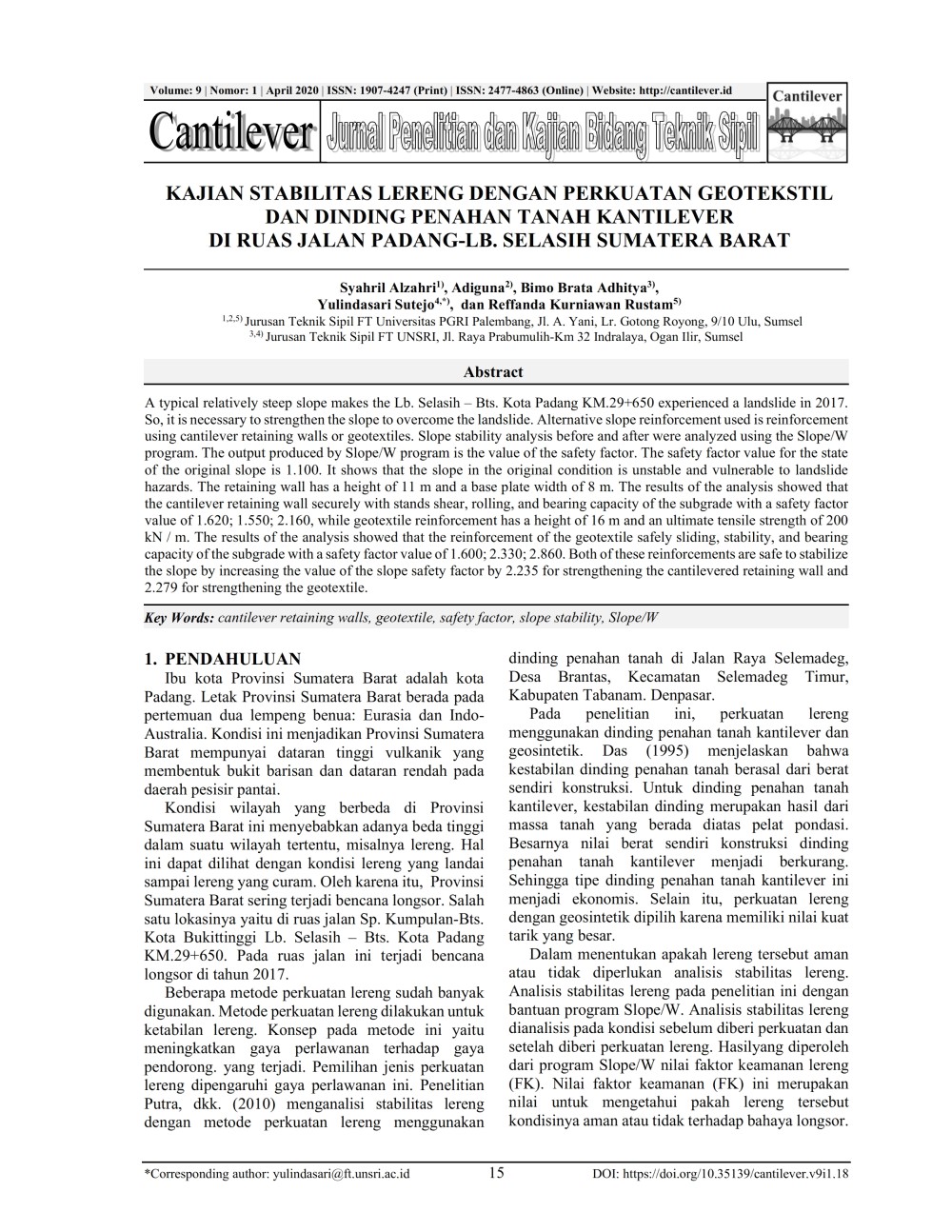Kajian Stabilitas Lereng dengan Perkuatan Geotekstil dan Dinding Penahan Tanah Kantilever di Ruas Jalan Padang-Lb. Selasih Sumatera Barat Study of Slope Stability with Geotextile Reinforcement and Cantilever Retaining Walls on Padang-Lb. Selasih Road, West Sumatra
Main Article Content
Abstract
A typical relatively steep slope makes the Lb. Selasih – Bts. Kota Padang KM.29+650 experienced a landslide in 2017. So, it is necessary to strengthen the slope to overcome the landslide. Alternative slope reinforcement used is reinforcement using cantilever retaining walls or geotextiles. Slope stability analysis before and after were analyzed using the Slope/W program. The output produced by Slope/W program is the value of the safety factor. The safety factor value for the state of the original slope is 1.100. It shows that the slope in the original condition is unstable and vulnerable to landslide hazards. The retaining wall has a height of 11 m and a base plate width of 8 m. The results of the analysis showed that the cantilever retaining wall securely with stands shear, rolling, and bearing capacity of the subgrade with a safety factor value of 1.620; 1.550; 2.160, while geotextile reinforcement has a height of 16 m and an ultimate tensile strength of 200 kN / m. The results of the analysis showed that the reinforcement of the geotextile safely sliding, stability, and bearing capacity of the subgrade with a safety factor value of 1.600; 2.330; 2.860. Both of these reinforcements are safe to stabilize the slope by increasing the value of the slope safety factor by 2.235 for strengthening the cantilevered retaining wall and 2.279 for strengthening the geotextile.
Downloads
Article Details
Das, B. M. (1993). Mekanika Tanah : Prinsip-prinsip Rekayasa Geoteknis Jilid II. Jakarta: Penerbit Erlangga.
Das, B. M. (1995). Mekanika Tanah : Prinsip-prinsip Rekayasa Geoteknis Jilid I. Jakarta: Penerbit Erlangga.
Hardiyatmo, H. C. (1995). Mekanika Tanah II. Yogyakarta: Gadjah Mada University Press.
Luriyanto A., Maulana I., Wulandari S. P. R., & Atmanto, I. D. (2014). Analisis Stabilitas Lereng dan Alternatif Penanganannnya : Studi Kasus Longsoran pada Ruas Jalan Pringsurat KM. MGL. 22+631 – 22+655 Kabupaten Temanggung. Jurnal Karya Teknik Sipil, 3(4), pp. 861–889.
Putra, T. G. S., Ardana, M. D. W., & Aryati M. (2010). Analisis Stabilitas Lereng pada Badan Jalan dan Perencanaan Perkuatan Dinding Penahan Tanah : Studi Kasus Jalan Raya Selemadeg, Desa Brantas, Kecamatan Selemadeg Timur, Kabupaten Tabanam. Jurnal Ilmiah Teknik Sipil, 14(1), pp. 36-42.
Rawi, O. A. & Abade M. A. (2017). Design of Geo-Synthetic Retaining Walls as an Alternative to the Reinforced Concrete Walls in Jordan. American Journal of Engineering Research, 6(12), pp.301-312.
Sosrodarsono, S. (2000). Mekanika Tanah dan Teknik Pondasi. Jakarta: Pradnya Paramita.
Temur, R. & Bekdas, G. (2016). Teaching Learning-Based Optimization for Design of Cantilever Retaining Walls. Istanbul: Department of Civil Engineering of Istanbul University.

This work is licensed under a Creative Commons Attribution-NonCommercial 4.0 International License.
Authors who publish with this journal agree to the following terms:
- Authors retain copyright and grant the journal right of first publication with the work simultaneously licensed under a Creative Commons Attribution-NonCommercial 4.0 International License that allows others to share the work with an acknowledgment of the work's authorship and initial publication in this journal.
- Authors are able to enter into separate, additional contractual arrangements for the non-exclusive distribution of the journal's published version of the work (e.g., post it to an institutional repository or publish it in a book), with an acknowledgment of its initial publication in this journal.
- Authors are permitted and encouraged to post their work online (e.g., in institutional repositories or on their website) prior to and during the submission process, as it can lead to productive exchanges, as well as earlier and greater citation of published work (See The Effect of Open Access).
